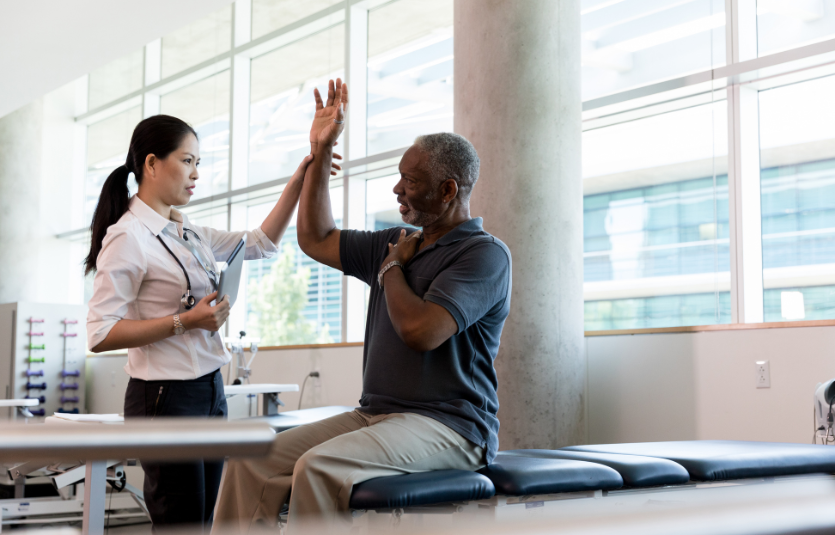At Riverside, we know that constant shoulder or elbow pain doesn't have to be a way of life.
To relieve your pain and inflammation, your doctor may recommend joint injections, physical therapy and other therapies. But, for some, the nonsurgical route doesn't provide enough pain relief and surgery is the next level of treatment.
Some of the most common shoulder and upper arm conditions that orthopedic surgeons see include:
Your rotator cuff consists of muscles and tendons in your shoulder. Tearing any of these muscles either through overusing the shoulder or falling on it can cause shoulder pain and weakness.
Shoulder arthritis is inflammation in the shoulder joint that causes pain and trouble moving your shoulder. You can experience multiple types of shoulder arthritis, including:
- Avascular necrosis (AVN) where bone cells in your shoulder die due to a lack of blood flow
- Post-traumatic arthritis due to injuries or surgeries in the shoulder
- Rheumatoid arthritis, also called inflammatory arthritis, is caused by an autoimmune disorders
- Osteoarthritis, which can affect the acromioclavicular joint (the joint by your collar bone) or your glenohumeral joint (the joint where your arm meets your shoulder socket) due to wear and tear on your shoulder over time.
If doctors don’t repair a rotator cuff tear, it can lead to rotator cuff arthropathy. In this condition, your shoulder bones rub together, causing irritation, pain and weakness.
Proximal humerus fractures are broken bones in your upper arm or shoulder. They can be caused by car accidents or bad falls. If you break your bone, you will feel pain and may not be able to move your arm at all.
Your labrum is the cartilage that lines your shoulder joint. If the labrum tears, it can cause pain, trouble lifting your arm and a grinding or popping feeling when you move your arm.
Your bicep muscle connects to your shoulder joint via a tendon. If you overuse this muscle by lifting overhead over and over or making similar motions, these tendons and even the bicep muscle can tear, leaving your shoulder weakened.
Your AC joint is where your collar bone meets the highest point of your shoulder. Arthritis here most commonly occurs in middle-aged and older adults.
The subacromial area of your shoulder runs beneath your collar bone. Your rotator cuff tendons run through this area. They become “impinged” or pinched if they are irritated or inflamed.
Your distal bicep tendon attaches your bicep to the front of your elbow. In the rare case that it detaches from the bone, your bicep muscle can become bunched up around your shoulder, creating a bulge and severe pain.
The muscles that make up your triceps attach to the back of your elbow. If the tendon ruptures, you won’t be able to fully extend your arm.
Shoulder surgeons can perform dozens of minimally invasive and open surgeries to improve your shoulder function. From repairing tendons to replacing the shoulder joint, these specialized orthopedic surgeons help relieve pain and improve your quality of life.
Arthroscopic surgery uses small incisions and a specialized camera and tools to repair tendons, ligaments or cartilage issues. During arthroscopic rotator cuff repair, shoulder surgeons can insert the camera through an incision near your shoulder and then use special tools to reconnect torn areas of your rotator cuff.
If your doctor can’t fully repair your rotator cuff, you might need arthroscopic superior capsular reconstruction instead. In this procedure, your orthopedic surgeon will connect your arm bone to your shoulder with grafted tissues. This connection helps support your shoulder so it can move as it should.
In this arthroscopic procedure, your doctor will look inside your shoulder joint for bone spurs, tissues or other growths that could painfully press against your shoulder tendons. To relieve pain, they can remove the bone spurs and part of the acromion (shoulder bone).
During biceps tenodesis, a minimally invasive surgery, your doctor can detach your torn bicep tendon from your shoulder and reconnect it to your upper arm. This procedure can help eliminate pain when you move your arm.
Shoulder replacement surgery treats severe arthritis pain in your shoulder joint. Your surgeon will place a metal ball at the top of your arm bone and a plastic liner in your shoulder socket. The ball articulates with the liner, mimicking the motion of your natural shoulder joint.
In a reverse shoulder replacement, your surgeon places a metal ball in your shoulder socket and a plastic cup at the top of your arm bone. This type of shoulder replacement might be more effective for people who have suffered rotator cuff tears.
Sometimes your clavicle (collar bone) can compress the tendons in your shoulder, causing pain. In this procedure, your doctor removes part of your clavicle to relieve pressure and pain.
During distal biceps repair, your surgeon uses minimally invasive methods to reattach your bicep to your arm bone. After the procedure, you will be able to use your arm better and regain your strength.
Similar to biceps repair, your shoulder surgeon reattaches your triceps muscle to the back of your arm bone during this procedure. As your body heals, you’ll regain function in your arm.
